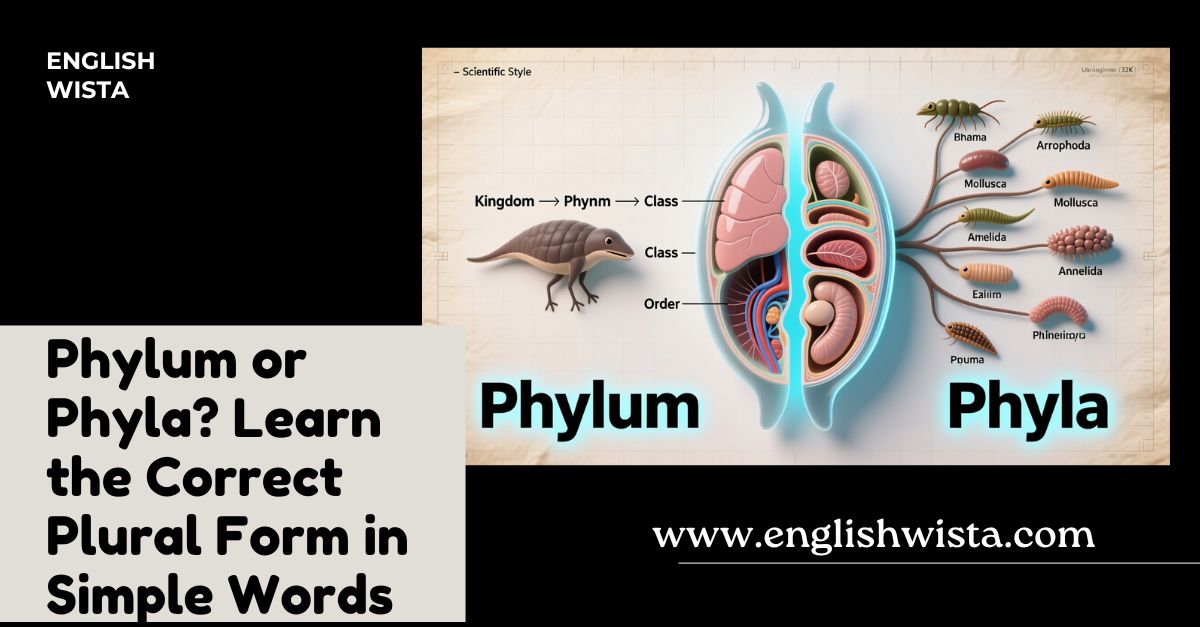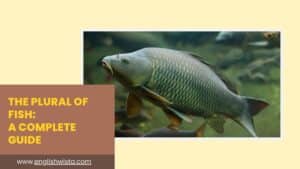Have you ever read a biology book and stumbled upon the word phylum? It probably looked a little intimidating at first. Then maybe you saw phyla somewhere else and wondered, “Wait, is that the same thing? Which one is correct?” If that thought ever crossed your mind, you’re not alone.
The word phylum is used a lot in science, especially in biology, to classify living things. But like many scientific terms, it doesn’t follow the usual English rules for making plurals. Instead, it comes from Greek, which is why its plural form looks a little unusual.
In this article, we’re going to explore the word phylum in a simple, conversational way. We’ll look at what it means, how to make it plural, why it’s written that way, and how to use it in everyday sentences. By the end, you’ll never be confused between phylum and phyla again!
So, let’s dive in.
What is a Phylum?
Before we even talk about the plural, let’s make sure we understand the word itself.
A phylum is a scientific term used in biology. It is one of the major groups used to classify living things. Imagine a giant family tree of life. At the top, you have the biggest categories, and as you move down, the groups get smaller and more specific.
Here’s a quick breakdown of biological classification from largest to smallest:
- Kingdom
- Phylum
- Class
- Order
- Family
- Genus
- Species
So, a phylum is the level right below kingdom. For example:
- Animals belong to the Kingdom Animalia.
- Within that kingdom, there are different phyla such as Arthropoda (insects, spiders, crabs), Chordata (humans, birds, fish), and Mollusca (snails, clams, squids).
Think of a phylum as a big category or bucket that holds many similar kinds of living creatures.
What is the Plural of Phylum?
Here’s the main answer you’ve been waiting for:
The plural of phylum is phyla.
So, if you’re talking about one group, you say a phylum. But if you’re talking about many groups, you say phyla.
- Singular: phylum
- Plural: phyla
Pretty simple once you see it, right?
Why Isn’t the Plural “Phylums”?
Great question! In English, we usually make plurals by adding “-s” or “-es.” For example:
- Book → Books
- Dish → Dishes
- Cat → Cats
So, it feels natural to want to say phylums. But here’s the twist: the word phylum comes from Greek, not from regular English roots. Many Greek (and Latin) words that entered English keep their original plural endings.
That’s why:
- Phylum → Phyla (Greek style)
- Similar examples:
- Datum → Data
- Criterion → Criteria
- Phenomenon → Phenomena
So, while phylums might look logical in English, it’s not the correct scientific plural. In biology and academic writing, phyla is the standard form.
Is “Phylums” Ever Used?
Technically, some English speakers (especially outside of science) do say phylums. It pops up in casual writing or when people don’t know the Greek plural form. However, in scientific contexts like textbooks, research papers, or classrooms the correct plural is always phyla.
If you want to sound accurate and professional, always use phyla.
Examples in Sentences
Let’s make this clearer with some simple examples.
- Singular examples:
- The animal kingdom is divided into many phylum groups.
- Chordata is the phylum that includes humans.
- Plural examples:
- There are more than 30 recognized animal phyla.
- Arthropoda and Mollusca are two very different phyla.
- Scientists study various phyla to understand the diversity of life.
Notice how much smoother it sounds when you use the correct plural form.
A Quick Definition Recap
- Phylum (singular): A major group in biology used to classify living organisms.
- Phyla (plural): More than one phylum.
Think of it like this:
- One basket = phylum
- Many baskets = phyla
Word Origin: Where Does “Phylum” Come From?
Now for a fun fact! The word phylum comes from the Greek word phylon, which means “race” or “tribe.” In the 19th century, scientists borrowed this word to describe large groups of organisms.
That’s why the plural follows Greek rules instead of English ones. Instead of adding an s, it changes to phyla.
Comparing with Other Tricky Plurals
The word phylum isn’t alone in this. English is full of scientific or borrowed words that don’t use the regular plural system. Here are a few examples for comparison:
- Datum → Data
(One piece of information → Many pieces of information) - Bacterium → Bacteria
(One single microbe → Many microbes) - Oasis → Oases
(One desert watering hole → Several watering holes) - Criterion → Criteria
(One standard → Multiple standards)
Just like phylum → phyla, these words remind us that English can be a little quirky because it borrows from so many languages.
Real-Life Uses of Phyla
So, when would you actually use the word phyla in real life? Let’s imagine a few situations:
- In a classroom:
“Today we’re going to learn about the different phyla of animals.” - In a research lab:
“Our study compares species across three distinct phyla.” - In everyday curiosity:
“I just found out that jellyfish and insects belong to different phyla!”
Even if you’re not a scientist, knowing how to use the word makes biology reading much less confusing.
Fun Facts About Phyla
Here are some cool extras to keep things interesting:
- Scientists recognize over 30 animal phyla today. Some are huge (like Arthropoda, which includes insects, spiders, and crabs), while others are tiny and obscure.
- Humans belong to the phylum Chordata because we have a backbone.
- The largest phylum by number of species is Arthropoda think of all the bugs, crustaceans, and arachnids!
- The term phylum wasn’t widely used until the late 1800s, when biologists began organizing life into more structured categories.
Quick Memory Trick
Here’s an easy way to remember the plural:
Think of phylum → phyla like album → alba (not exactly, but close in sound). Or even better, remember it as one phylum, many phyla.
Repeating that phrase a couple of times will lock it into your memory.
Conclusion
So, what did we learn today?
- A phylum is a big category in biology that groups living organisms.
- The plural of phylum is phyla, not phylums.
- This irregular plural comes from Greek, which is why it looks different from normal English plurals.
- Using the correct form makes you sound clear, accurate, and confident, especially in scientific discussions.
Next time you read about animals, plants, or microbes, you’ll know exactly what it means when someone says there are “many phyla.” It’s just the plural of phylum.
And remember, English is full of these little surprises words borrowed from other languages that keep their original style. But once you learn them, they’re easy to handle.
So the key takeaway is simple: One phylum, many phyla.



